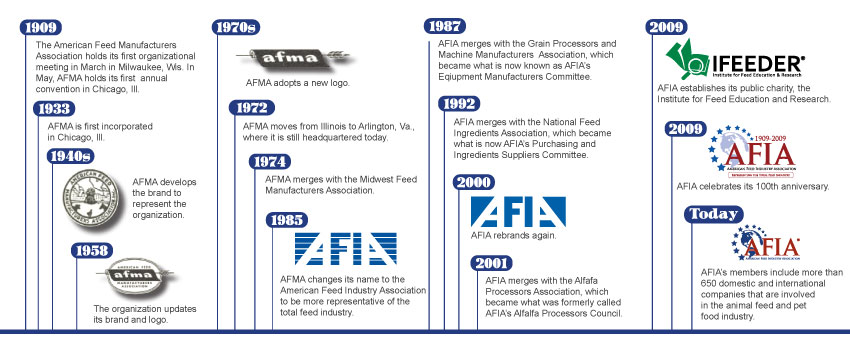AFIA's History
The Need for Representation
In the 1800s, entrepreneurs and inventors in the flour milling, brewing and sugar milling industries began wading into animal nutrition, developing food and beverage processing systems and new ways to use byproducts in feed. As the science of animal nutrition evolved, soon, state regulatory agencies began to take note of this burgeoning industry.
In 1906, Congress enacted the landmark Federal Pure Food and Drug Act, which gave federal officials the authority over feeds shipped in interstate commerce. Realizing a need to stay informed about these new regulations, in 1909, the industry assembled in Chicago and created the American Feed Manufacturers Association, the organization from which AFIA stems.
AFIA has also enjoyed a longstanding relationship with the Association of American Feed Control Officials, an association of state and federal agencies charged by law with regulating the sale and distribution of animal feeds and animal drugs. AFIA has participated in an unbroken chain of cooperative meetings biannually with AAFCO since its establishment in 1909. With a common goal of creating sound legislation based on the AAFCO Model Feed Bill – one developed by consensus – the organizations are engaged in using each other’s expertise to develop state feed laws and regulations that are rooted in science.

Evolution of the Industry
As the world economics have changed and the industry has researched, developed and adopted new technology, the association has evolved. By the 1920s, feed was already a billion-dollar industry. By the 1940s, corn yields were beginning to explode, and with each passing decade, so were soybeans. Farmers, nutritionists and manufacturers began to grow more sophisticated crops and engineer new uses.
In 1972, the AFMA’s offices moved from Illinois to the outskirts of Washington, D.C. Major publications were revamped to serve an industry in constant transition with new government regulatory laws and regulations coming several times a year.
Mergers and the Changing Faces of Membership
When the AFMA and the Midwest Feed Manufacturers Association agreed to merge in 1974, it highlighted the broad question about how to represent the total feed industry. During the 1980s and 1990s, the AFMA changed its name to the American Feed Industry Association and merged with the Grain Equipment Manufacturers Association, National Feed Ingredients Association and the Alfalfa Processors Association.
By the early 2000s, the AFIA looked dramatically different than it had in recent years. It was during this time that the organization needed to take a critical look at the future value and service it would provide to the industry. At the core of the effort, a greater emphasis on member participation and input. The AFIA undertook a number of new efforts to tangibly demonstrate its value to members, especially in the area of legislative and regulatory representation – which was retained as a central role for the organization.
Providing a Consistent Policy Focus Throughout its History
Since 1909, the AFIA has worked to manage priority legislative and regulatory issues on behalf of its members. In fact, representation on key policy issues before federal policymakers and regulators is still a primary reason that members join the association today. The AFIA accomplishes this by fostering relationships with decisionmakers and building alliances with other allied agricultural organizations, amplifying the industry’s voice on Capitol Hill.
As our number one priority, there is a process in which the AFIA works with its members and committees to solicit input and develop the AFIA’s positions on key policy issues. The staff then brings forward the recommendations to the AFIA leadership for review and approval. The AFIA Board of Directors ultimately approves the priorities, providing the association with its strategic focus for the year.
The balance of the AFIA’s services, including meetings and events, is fairly self-sufficient, as the members vote with their registrations and participation. The association also provides members with resources they can use to communicate the industry’s message with one voice.